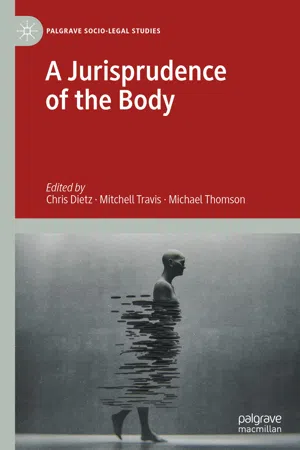The lack of emphasis on bodies has given rise to the liberal conception that bodies are largely interchangeable in their interactions with societal institutions, including law and the healthcare system. Liberal framings, such as
human rights discourse, have become the dominant language for thinking about law and the body. These tend to be premised upon the supposed universality of the human body. Yet the meaning of humanity, or even biology, is subject to both social and cultural concerns. As Fuss (
1996: 1) has claimed: ‘the human is a linguistic, cultural, and sociopolitical construct of comparatively recent date’. For Fuss, the concept of the human is more than a simple genetic relation. Instead, it relies upon political and cultural ideology to include and exclude entities from its boundaries at different times. As a consequence, it is unsurprising to find that broader liberal legal considerations have, for the most part, categorised the body ‘as an object of analysis rather than as a category of analysis’ (Fletcher et al.
2008: 321). This point of focus has failed to account for the value that society places on the living physical body, particularly in terms of our interactions with others and its facilitation of our experience of being in the world (Fletcher et al.
2008: 321). Hyde (
1997) notes that the law uses a variety of unsuccessful conceptualisations when dealing with the body, including property, privacy right and machine. Each of these metaphors fails to encapsulate the importance of the body. As Naffine writes, there has been a shift in legal theory from a bodiless conception of law to a particular type of (assumedly interchangeable) body:
the rational and therefore responsible human legal agent or subject: the classic contractor, the individual who is held personally accountable for his civil and criminal actions. This is the individual who possesses the plenitude of legal rights and responsibilities, the ideal legal actor … he who asserts his will, who grasps and asserts his legal rights. Now there is a discrete possessor of rights. (Naffine 2003: 362)
Principles of liberty, equality and freedom operate to allow individuals the same opportunities for flourishing within Western states. Liberal understandings of meritocracy suggest that anyone can achieve anything—even good health—provided they work hard enough for it. In turn, anti-discrimination law has become prominent in order to prevent people from being unfairly discriminated against on the basis of the particularities of their bodies. In this theoretical tradition, bodies are understood as interchangeable. The ‘he’ so often used in legislation can be applied to women, while race and disability are not important aspects for the purposes of general (non-specific) legislation. Despite this, indicators such as race, class and disability all have an important effect on outcomes in terms of wealth distribution, educational attainment, criminalisation and health. The interchangeable ‘anybody’ assumed by
liberalism has been shown to privilege a particular type of body. Whiteness, maleness, being able bodied and inheriting wealth are all advantaged by institutions that assume a lack of
dependency on the
state (Fineman
2004; Brown
2015). Again, as Naffine notes:
the rational subject must be a fully individuated and integrated physical being before he can begin to assert his will against all other subjects. An explicit biological assumption is therefore that this individual is a rational adult human; a tacit assumption is that this rights-asserting competent legal actor is individuated and therefore sexed (at least in the sense of never pregnant, because this compromises individuation). Individuation and self-containment are essential if the rational subject is to be free to act in ways which affect only his self: if he is to be fully capable of confining and containing the effects of his actions to himself and to no other. (Naffine 2003: 364)
Some individuals are able to ‘fit’ into society precisely because of their ability to navigate the everyday topography of existence (Garland-Thomson
2011). This liberal legal
subject is afforded material anonymity that is available only to individuals who share characteristics of masculinity,...
